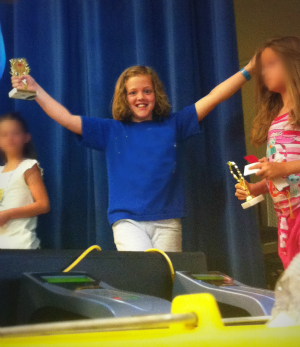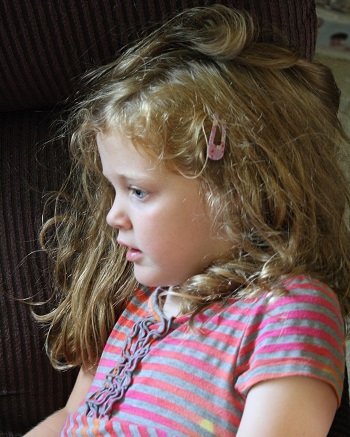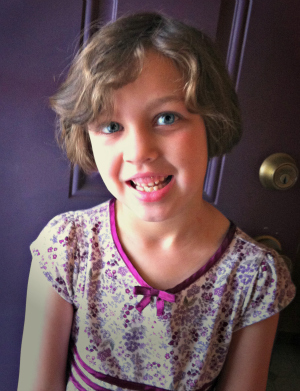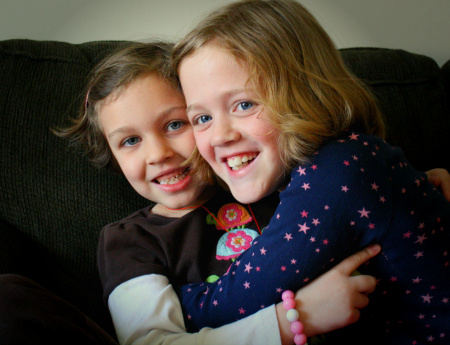Cordy had her first meeting with a behavioral therapist last week. Her psychologist had recommended setting up a meeting, but it had slipped my mind until last Wednesday when the therapist called and asked if we could meet that Friday. At our house. (Yes, I frantically cleaned.)
The meeting went well, I think. The behavioral therapist wanted to get a general assessment of Cordy’s personality, as well as what she’s struggling with and where she needs help. Since it was at our house, I expected that Cordy, having been tired already from summer camp that day, would probably let her guard down and just be herself.
Cordy is a smart kid. She’s aware that she’s different from other kids and when Cordy is at school or summer camp, she tries her best to hold in a lot of her quirks. Her teachers see very little stim behavior in the classroom, with only a little more of it on the playground. She rarely snaps at anyone at school. But at home, she knows she’s in a safe space and usually lets off steam as soon as she gets home. She’ll often flap, pace, make up a story to herself, or isolate herself with a book or computer time. If we ask anything of her, she’ll sometimes overreact and snap at us.
Meeting the therapist, however, she kept up the in-public facade for most of the hour. She was sweet and charming, answering the therapist’s questions and asking several questions of her own. There was no stimming, other than a little bit of wrestling with the dog at one point.
But the disconnect was still there. Cordy had a book in her hand nearly the entire time, and if she lost interest for even a moment, her face was quickly hidden behind the turning pages. She became loud and almost shriek-y when talking about the things she fears (bees, bugs, roller coasters, Kaos in Skylanders, the dark), although she wouldn’t discuss the real social anxieties that make it hard for her to function at times.
And she became upset with me when I told the therapist about where she needed to improve in her life skills, listing age-appropriate self-care tasks and basic safety precautions that we’d like her to do on her own but have seen little success. Cordy tried to shush me, saying I was “giving away all of [her] secrets.” She’ll gladly talk superficial fears and tasks that she has trouble with, but when we try to talk about real anxieties and areas of deficit, she becomes hyper-sensitive and doesn’t want anything said. My daughter, the perfectionist. The therapist said that’s a very common trait of gifted and twice-exceptional children – they hold themselves to nearly impossible standards and can’t stand for anyone to think they’re not perfect.
 And most kids just accept an end of the school-year award and stand on the stage. Cordy is ready to give an acceptance speech for being The Best. We should probably add modesty to our list to work on.
And most kids just accept an end of the school-year award and stand on the stage. Cordy is ready to give an acceptance speech for being The Best. We should probably add modesty to our list to work on.
It was surprisingly difficult to talk so much about Cordy’s issues. I usually try to balance everything out with a positive quality for every problem area, like “Well, she doesn’t really have any close friends…but she’s so sweet to other kids and can tell great jokes!” Not to mention, Cordy was sitting right there in the room with us – what if she was internalizing everything I said? Sure, she was mostly absorbed in a book when I was talking and likely heard little of the conversation, but I was carefully considering every word choice in the moment so Cordy wouldn’t think I didn’t like her for her faults. I danced around each topic, pointing to “areas to strengthen” and “ways to help her be more successful” instead of “problem areas” or “bad behavior.”
And I wasn’t sure where to draw the line in sharing so many of my daughter’s weaknesses – did I sound like the hypercritical parent who considers her child “broken” over a bunch of faults (oh, I hope not!) or did I dismiss her problems too much and make it appear that she really doesn’t need any help and I’m making a big issue out of nothing? I named several problem areas (that I didn’t call problem areas), big and small, specifically to have them said out loud to a professional, so that we might then find solutions to overcome these issues.
The therapist listened intently and took a lot of notes during our discussion. She plans to consult with the psychologist to determine where to begin, and then we’ll start working on learning new adaptive skills in two weeks. I’m hoping this will be a new period of great progress and growth for Cordy. I only want for her to be better prepared for the world around her and help her better cope with her peers and the outside world before she reaches (oh…it’s hard to even think about this) puberty.
Because we all remember middle school (some of us would rather not), and I think few would say that the majority of 11-13 year old kids are tolerant and accepting of peers who are different and don’t quite fit in. I’d like to be proven wrong on that statement, but I have my own emotional scars from middle school and I’d also rather prepare my daughter for what’s ahead.
I don’t expect or want her to conform to the behavior of her peers, although I do want her to better understand “typical” social behavior if only to know what is OK from her peers and what is rude or harassing behavior that she should not tolerate. And a little part of me wants her to learn the social game, if only a little, so that she might find enjoyment in friendships.
We’ll see how this goes, but I’m hoping for good results.





